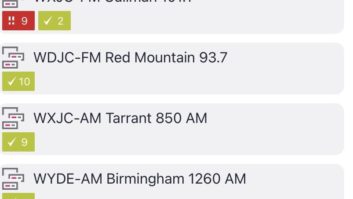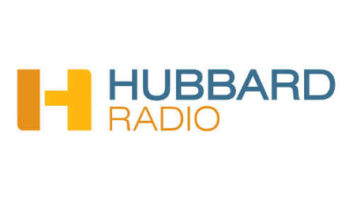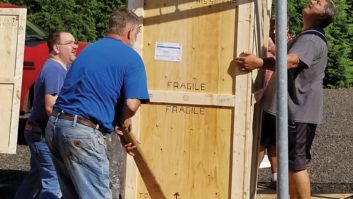Installing AM IBOC
May 1, 2005 12:00 PM, By John Battison, P.E., technical editor, RF
The basic installation of an AM IBOC transmitter is similar to that for an FM IBOC installation with varying exceptions required by the different system of operation. Although new AM stations are still being built, the majority of AM transmitters that are being converted to IBOC will be existing facilities that will have to be modified to handle digital transmission and operation. A typical existing AM station will require considerable attention to its audio and studio facilities, but the majority of work will probably involve modifications to the existing transmission system.
The basic items to consider are the method of producing AM IBOC, the radiator system and transmission lines, the transmitter itself, possible changes in primary power requirements and the STL.
Upgrade or all-new
If an existing facility is being upgraded, several areas will require consideration before final project plans are prepared. The first one is site security. Unfortunately, the days of rather haphazard and sketchy security are long gone. Steel fences around tower bases and studio/transmitter buildings are requisite these days. Many of us can recall going out to a remote transmitter in a relatively insecure building on a dark night and not feeling in much danger. Today conditions call for high steel fences, fortress-type building construction and well-illuminated areas. If the newly acquired site is a building with other businesses, security is the first requirement that must be satisfied.
In addition to robbery and vandalism safeguards, protection must be provided against fire and also to ensure primary power supply continuity. This calls for a UPS. How these items are handled depends on local conditions as well as budget considerations. However, they are of primary importance. These items apply equally to digital or hybrid operation but they warrant careful consideration.
An existing AM operation may be assumed to have an operating AM antenna. If the station is non-directional, less antenna work is required. The FM antenna can be mounted on the existing AM tower and the most convenient method of getting the FM line across the base insulator can be used. Remember that even though an isolator is used a new base operating impedance measurement will be required. In the event that a shunt-fed AM antenna is being used this measurement is not as critical.
In the case of a directional array, the addition of an FM antenna on one of the towers may cause more work. If one of the towers is already supporting an auxiliary antenna use this tower to support the new FM antenna, provided that the tower will carry the load of the new antenna and transmission equipment. Once again, be sure to get a structural engineer’s report before adding the new antenna.

Figure 1. The greatly increased use of sidebands in AM IBOC requires maximum antenna system bandwidth. Click here to enlarge this image.
In with the new
Someone will need to decide the fate of the old transmitting equipment. Unless the existing AM transmitter is new, install a solid-state transmitter because it will have been designed with new techniques in mind and will handle IBOC without any problems. Unfortunately, tube transmitters seem to have more trouble with linearity, and good linearity is essential for hybrid and all-digital AM IBOC operation.
Keep in mind that space may be required for a hybrid injector and combiner in the transmitter room. However, the IBOC system is constantly changing and improving itself so that eventually one may not be required.
Space for the new transmitter will be required adjacent to the existing transmitter and possibly any other additional RF equipment. In the case of a directional station, don’t do anything to change the transmission lines length between the phasor and the tower bases. This caveat also applies to the antenna monitor lines because any changes to the transmission lines or the antenna monitor lines will automatically involve a new partial proof of performance.
Wider is better
Successful AM IBOC transmission requires adequate bandwidth in the AM antenna. Figure 1 shows the basic typical hybrid AM IBOC waveform and the effect of inadequate bandwidth can easily be observed. A transmitter and antenna system suitable for stereo AM for hybrid IBOC should work well.
Fine-tune the antenna system as closely as possible to 50ohm+j0 impedance and the sidebands should be symmetrical with amplitude symmetry as near as possible to 0.02dB. This will ensure proper quadrature operation and minimize crosstalk between analog and digital channels.
In many cases deep nulls in directional antenna patterns result in inferior reception in regular AM operation. This is usually caused by rapid changes in antenna characteristics at the side band frequencies. This factor should be considered when selecting an AM operation for conversion to hybrid IBOC because deep null reception is frequently poor under these conditions. Consider this point long before deciding on an AM operation to be converted to AM hybrid IBOC.
Additional rack space will be required to accommodate equipment for the new digital signals, such as audio processing. Audio considerations should follow along the same lines as those for digital IBOC operation, and modified as required for the digital and analog portion of the hybrid installation. The IBOC signal will only be as good as the audio that is fed into the transmitter. This means that all studio wiring must be in accordance with AES specifications. If excessive bit reduction is used, audio degradation can occur. When planning audio monitoring systems remember the time delay caused by IBOC.
Treatments for STL problems and requirements depends on the type of installation, path considerations, audio processing and budget. If the audio processing is at the studio, two audio paths may be required. If audio processing is the at the transmitter site, a single STL system may be used. To obtain maximum AM IBOC performance system equivalence to an AM stereo system will be needed. The second generation of IBOC transmission equipment simplifies this process with an exporter and importer.
E-mail Battison at[email protected].







